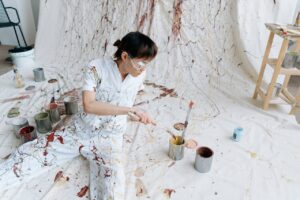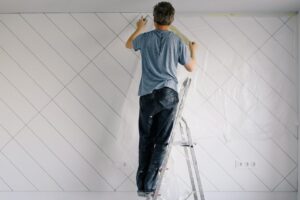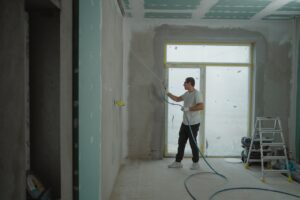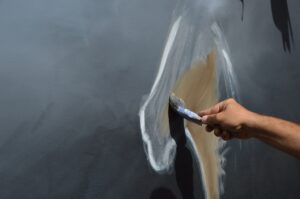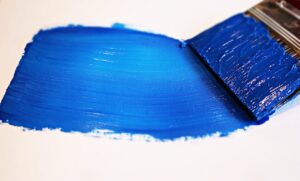Why Wood Surface Painting Is Vital For Protecting Against Weather Damage
Wood surfaces exposed to the elements face significant risks of weather damage. Untreated wood can deteriorate quickly, leading to structural issues and a shortened lifespan. That’s why wood surface painting is vital for protecting against weather damage. By applying a protective barrier of paint, you create a shield that safeguards the integrity of the wood from exposure to rain, sunlight, and other elements. This proactive measure helps prevent moisture penetration, which can lead to rotting and decay. Paint acts as a barrier against UV radiation, reducing the risk of color fading and maintaining the aesthetic appeal of your wooden surfaces. We’ll delve into the benefits it offers in terms of preserving the structural integrity of buildings and enhancing their visual appeal. Significance Of Wood Painting Weather Defense Painting wood surfaces is vital for protecting against weather damage. When wood is exposed to harsh weather conditions such as rain, sun, and extreme temperatures, it can deteriorate over time. However, a layer of paint acts as a shield, providing a protective barrier that helps extend the lifespan of wood surfaces. By properly painting wood, you can make it less susceptible to damage caused by the elements. Moisture Blockage One of the key benefits of painting wood surfaces is the creation of a moisture-resistant layer. This layer prevents water absorption into the wood, which is essential for preserving its structural integrity. When wood absorbs moisture, it becomes prone to rotting, warping, and swelling. By applying paint to wooden structures and furniture, you effectively block moisture from seeping in and keep them structurally sound. Mold Reduction Painting wood surfaces not only protects against weather damage but also inhibits mold growth. Mold thrives in damp environments and can cause health issues if left unchecked. However, when you properly paint a surface, you create an unfavorable environment for mold to grow on wood. This reduces the risk of mold-related damage and helps maintain indoor air quality. Insect Prevention Wooden structures are vulnerable to insect infestations if left unprotected. However, by painting these surfaces, you create an additional barrier that deters insects from burrowing into the wood. Termites and other damaging pests are less likely to invade painted surfaces compared to untreated ones. Preventing insect infestations through painting helps preserve the integrity of wooden structures. Choosing Wood And Paint Right Wood Species Choosing the appropriate wood species for painting is vital to protect against weather damage. Certain types of wood are naturally more resistant to decay and rot when painted. For example, cedar and redwood have natural oils that make them highly durable in outdoor conditions. By selecting the right wood species, you can enhance the effectiveness of paint in safeguarding your wood projects from the elements. Quality Finishes Investing in high-quality finishes is crucial for providing superior protection against weather elements.Using premium paint products ensures long-lasting durability and resistance. These paints are specially formulated to withstand harsh weather conditions such as rain, snow, and UV rays from the sun. By opting for a professional paint job with quality finishes, you can significantly increase the lifespan of your wooden surfaces. Sealants And Stains In addition to paint, applying sealants and stains before painting can offer added protection by penetrating the surface of the wood. Sealants create a barrier that prevents moisture from seeping into the wood, reducing the risk of rotting and warping. Stains not only enhance the appearance of your wood but also provide an extra layer of defense against weather damage. They help repel water and block harmful UV rays that can cause fading or discoloration over time. By using appropriate sealants and stains on your wood surfaces, you can improve their overall ability to withstand harsh weather conditions. When choosing paints for wood surface painting, it is important to consider factors such as durability, coverage, and color options. Look for paints specifically designed for outdoor use that offer excellent adhesion to different types of wood surfaces. Opt for paints that are low in volatile organic compounds (VOCs) to minimize environmental impact. To ensure a successful paint job on your wooden surfaces, proper preparation is key. Clean the surface thoroughly by removing dirt, dust, and any existing paint or stain. Sand the wood to create a smooth surface for better paint adhesion. Apply a primer before painting to enhance the durability and longevity of the finish. Preparation For Durability Surface Preparation Proper surface preparation is crucial. Before painting, it is essential to clean and sand the wood to ensure optimal paint adhesion. By removing dirt, dust, and any loose or flaking paint, you create a smooth surface for the new paint to adhere to. Neglecting this step can result in poor paint adhesion and premature weather damage. Imagine building a sandcastle on a rough, dirty beach. The sandcastle would not hold its shape well, and it would easily crumble. Similarly, if you apply paint on a dirty or uneven wood surface without proper preparation, the paint will not stick properly and may peel off over time. By taking the time to prepare the wood surface adequately, you increase the durability of your painted finish. Primer Importance Using a primer before painting is another vital step in protecting wood surfaces against weather damage. Primers provide a solid foundation for paint adhesion and help enhance the longevity of the painted surface. They act as an additional barrier between the wood and the elements. Think of a primer as an undercoat that prepares your wood surface for its final coat of paint. It helps seal any pores in the wood, preventing moisture from seeping in and causing rot or warping. Primers offer protection against UV rays that can fade or degrade the color of your painted surface over time. By using a primer specifically designed for exterior applications, you provide an extra layer of defense against rain, snow, sunlight, and other harsh weather conditions that can damage unprotected wood surfaces. Application Tips The way you apply paint to your wood surfaces also plays a role in their

